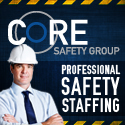By Jeff Shields and Travis Guenzler, Enterprise Fleet Management
Rock performer Meat Loaf sings about it and the National Highway Traffic Safety Administration (NHTSA) studies it. Although over the years the idiom “where the rubber meets the road” has been used to describe the “moment of truth,” it actually refers to the tires on the surface of the road. And, when it comes to driver safety – both meanings are appropriate.
“Studies of tire safety show that maintaining proper tire pressure, observing tire and vehicle load limits (not carrying more weight in your vehicle than your tires or vehicle can safely handle), avoiding road hazards, and inspecting tires for cuts, slashes, and other irregularities are the most important things you can do to avoid tire failure, such as tread separation or blowout and flat tires,” states an NHTSA booklet.
Under-inflated tires and low-tread depth are cited by NHTSA as the most significant tire problems contributing to an increase in collisions. While under-inflated tires lead to poor vehicle handling, tires with low-tread depth have less traction on the road, especially when roads are wet. Both can result in loss of vehicle control.
In addition, over-inflation can make tires more susceptible to road-hazard damage that can also impact vehicle handling, and overloading a vehicle can create excessive stress and heat, leading to tire failure. It’s important to note that tire inflation pressure increases in warm weather and decreases in cold weather as much as one to two pounds for every 10 degrees of temperature change.
There is no substitute for good maintenance measures:
- Observe guidelines for inflation pressure. Using a quality tire gauge, check tire pressure at least once a month and before any long road trips. The best time to check pressure is when tires are cold. For the proper cold-tire inflation pressure for individual vehicles, check the Owner’s Manual and/or the tire placard located inside the front driver side door.
- Rotate tires regularly. Just rotating tires regularly can extend tire life by as much as 20 percent. A good rule of thumb is to rotate tires during every other oil change, or more frequently depending on driving habits and road conditions. A rotation schedule may be suggested in the Owner’s Manual.
- Inspect tires monthly. Check tires on all vehicles monthly, paying particular attention to signs of wear or visible damage, as well as ensuring all valve caps are in place to help keep out dirt and moisture.
- Maintain vehicles “by the book.” Many vehicle components, including shocks, struts and brakes, can affect the tire’s performance. Ensure company vehicles are inspected regularly and follow the recommended maintenance schedule listed in the Owner’s Manual or provided by your fleet maintenance management provider.
Because tires are the only thing separating vehicles from the road, it’s extremely important to make sure they are in the best possible condition at all times. Manufacturers emphasize the need to select tires of the same brand, line, size, speed rating, load index and load range when replacement is needed. Failure to use equivalent replacement tires may adversely affect the safety, handling and vehicle performance.
When it comes to tire safety and maintenance, NHTSA sums up the benefits: “Proper tire care and maintenance can improve vehicle handling, help protect you and others from avoidable breakdowns and accidents, improve fuel economy and increase the life of your tires.”
Jeff Shields is a customer support team supervisor and Travis Guenzler is a customer support advisor for the National Service Department of Enterprise Fleet Management, a full-service fleet management business for companies with medium-size fleets which include most makes and models of cars, light- and medium-duty trucks and service vehicles across North America.
For more information about Enterprise Fleet Management’s environmental stewardship and long-term commitment to the sustainability of the fleet management business, visit http://drivingfutures.com/fleetmanagement/. For more information about Enterprise Fleet Management, visit www.efleets.com or call toll free 1-877-23-FLEET.

 2300 Wilson Boulevard, Suite 300 · Arlington, VA 22201 · 703-548-3118 (phone) · 703-548-3119 (fax) · www.agc.org
2300 Wilson Boulevard, Suite 300 · Arlington, VA 22201 · 703-548-3118 (phone) · 703-548-3119 (fax) · www.agc.org
 AGC Wins $120,000 Susan Harwood Training Grant
AGC Wins $120,000 Susan Harwood Training Grant



